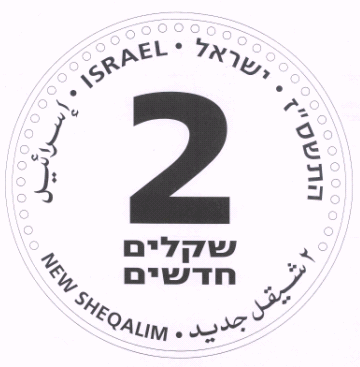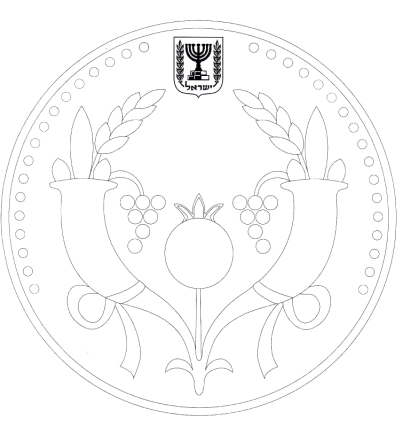| 8.8.2006 |
| |
| Bank of Israel: Growth in the use of cash, together with an increase in population and economic growth, pushed up currency in circulation in 2005 by 17.5 percent |
|
| |
| A new NIS 2 coin will be minted within a few months |
| The Annual Report of the Bank of Israel Currency Department[1] shows that currency in circulation, i.e., banknotes and coins in the hands of the public and in bank tills, totaled NIS 24.4 billion at the end of 2005, compared to NIS 20.8 billion at the end of 2004, an increase of 17.5 percent, a higher rate of growth than in previous years. (Between 2002 and 2004, currency in circulation grew by an annual average rate of 7.2 percent). The main factors behind this rise were the higher use of cash for transactions, growth in the economy and an increase in population in 2005. |
| According to the Bank's data, banknotes continue to comprise 95 percent of the value of currency in circulation, and coins make up the balance. More than half (51 percent) of coins in circulation were 10 agorot coins, used, inter alia, for change on local public transport. The NIS 1 coins, many of which are used for parking meters and vending machines, constituted 22 percent of all coins in circulation in 2005. The higher value coins––NIS 5 and NIS 10––accounted for only 3 percent each of total coins in circulation. |
| A not inconsiderable number of coins in circulation get lost, and so the actual use is less than that recorded. Loss is a natural consequence of heavy daily usage of coins, which are a low-value means of payment. The rate of loss is inversely proportional to the value and size of the coin. Estimates for the loss of coins in circulation range between 41 percent and 77 percent for the 5-agorot, 10-agorot, 1/2-sheqel and NIS 1 coins. |
| Greater use of NIS 100 and NIS 200 banknotes |
| The proportion of NIS 20 and NIS 50 banknotes used in circulation fell during the year, while the use of the higher value banknotes, NIS 100 and NIS 200, increased with economic growth. |
| The banknote with the highest rate of wear and tear was the NIS 20 note, due to its absence from ATMs––the ATM serving as a conduit to introduce new banknotes into circulation––its high velocity of circulation and the public's lack of safekeeping. To improve the life of the NIS 20 banknote, the Currency Department released an improved banknote in 2006 printed on higher quality paper with additional coating. |
| The year saw an increase of cash withdrawals from machines: the number of ATMs increased and cash dispensers––cash-withdrawal machines owned by private companies and operated by the businesses where they are sited––were introduced; at the same time there have recently been newer options of cash withdrawals through retail chains (in particular at gas stations). |
| Though December 31, 2005 was to be the last date for converting old banknotes of the new sheqel series (Series A), the Bank of Israel extended this period to 31 December 2010, as the public continued to hold significant quantities of the old series banknotes. This series came into circulation in 1985 and was replaced in 1999. |
| As part of the campaign against counterfeit money, the Bank of Israel, the Israel Police, the banks and the Banks Association set up a joint Forum Against Forgery, to prevent and locate counterfeiting. At its meetings, the forum discusses cases of counterfeiting that have occurred, and ways to improve the campaign against counterfeiters and those that distribute counterfeit money. |
| In 2005 the two branches of the Currency Department––Jerusalem and Tel Aviv––were merged. Services to the public are now provided only by the Jerusalem branch as the Tel Aviv branch could no longer meet the requirements of the Bank of Israel and the banks, due to considerations of security, cost saving, streamlining deposit procedures and improving work procedures. At the branch, the public can exchange defective currency and also exchange old series banknotes for new. |
| Coming soon: NIS 2 coin |
| In 2004 it was decided to introduce a new coin denomination––NIS 2––and the process accelerated in recent months with the convening of the Advisory Committee to the Bank of Israel, whose counsel is required by law before the final approval of the coin by the Minister of Finance. The issue process for the new coin will be completed in the next few months. The addition of the NIS 2 coin will make cash payments more efficient, particularly for the heaviest users, and will reduce spending on currency issues, so that expenditure on manufacturing and maintenance of cash will fall. |
| As with other coins in circulation, the design of the new NIS 2 coin was based on ancient Jewish coins of Yehochanan (John Hyrcanus), and depicts the double cornucopiae (or horns of plenty). The cornucopia is an ancient symbol from the Hellenic period when it appeared on coins and artworks. It is a hollow, animal's horn filled with fruit and grain and it has become a symbol of plenty. |
| New issues |
| In 2005 the Bank of Israel issued five commemorative coins and one set of special coins: an Independence Day Coin, 5765–2005, "The Golden Age"; a coin in the "Bible Art" Series, 5765–2005, "Moses and the Tablets of Stone"; a special gold edition of a coin in the "Bible Art" Series, depicting "Jacob and Rachel", 5764-2004; a coin commemorating Naomi Shemer, 5765-2005; a coin marking 100 years of the Theory of Relativity and 50 years since the death of Albert Einstein, 5765-2005; and a set of Hanukka coins, 5766–2005. |
| Numismatic exhibition in the Visitors' Center |
| The Bank of Israel is currently constructing an educational Visitors' Center where it will present the activities and policies of the Bank of Israel in the Israeli economy. As part of the center, there will be a rich numismatic exhibition, displaying the history of money from the invention of the first currency in the 7th century BCE up to today. |
| Currency Department publication |
| The Currency Department recently published Banknotes and Coins of Israel, 1927-2006, a book that presents the history of Israel's coins and notes from the British Mandate period until the present period, including details––from size and weight (of coins), design and name of designer to date of issue and last date of use––of all coins and banknotes issued. |
|
| |
The reverse side of the new NIS 2 coin
 |
|
| |
The obverse side of the new NIS 2 coin.
 |
|
| |
| The pictures here are not to scale. The coin will be silver colored with a ring diameter of 2.16 cm (compared to 1.8 cm of the NIS 1 coin and 2.4 cm of the NIS 5 coin). |
|
| |
|